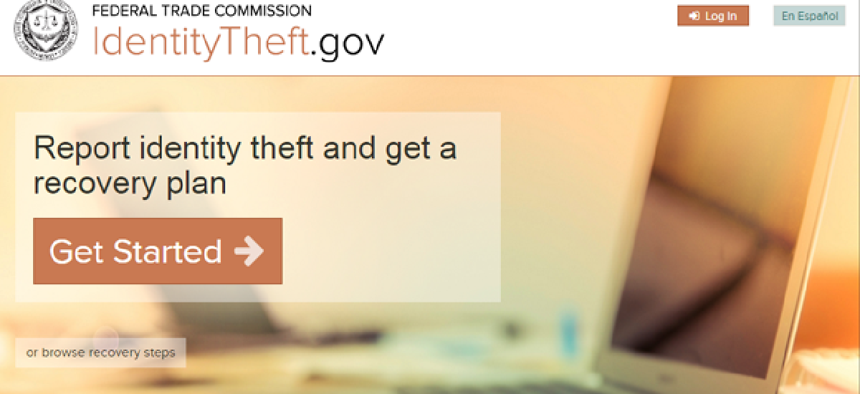Site doubles self-service processing of identity theft complaints


Connecting state and local government leaders
A Federal Trade Commission website helps victims find information about remedying a loss caused by identity theft, file complaints and get individualized guides for taking action.
Identity theft is a rampant problem that often leaves victims scrambling to protect themselves. To eliminate some of the guesswork associated with filing identity theft complaints, the Federal Trade Commission set up a new website.
Initially launched in May 2015 and significantly upgraded in January 2016, the FTC’s IdentityTheft.gov helps victims find information about remedying a loss caused by identity theft, file complaints and get individualized guides for taking action. It creates a report that proves to businesses that the identity has been stolen and makes it easier to for victims fix problems by generating documents, such as credit card dispute letters.
“Identity theft victims have numerous steps they have to take to solve their problems -- to remediate the issues that come up because of the identity theft, ” said FTC’s David Torok, who is associate director of FTC’s Division of Consumer Response Operations in the Bureau of Consumer Protection. "And those vary depending on what data was stolen and what was done with that data.”
When victims set up a secure account, the website guides them through a series of questions that ultimately results in a personalized recovery plan -- a page of step-by-step instructions, such as how to contact a company where a fraudulent identity was used. The wizard interface asks questions to collect information and narrow consumers’ inquiries so that the appropriate documents can be generated with prepopulated information and a suitable recovery plan suggested.
The information that victims enter also is compiled into an affidavit, their official statement to FTC. Anyone who files a complaint gets an affidavit, but only victims who create an account with IdentityTheft.gov get the individualized recovery guide at the end of the question-and-answer session.
To create IdentityTheft.gov, FTC partnered with Lockheed Martin. Work started in February 2015 and involved consumer-focused design workshops that let users offer feedback as the site took shape. The company also used an agile development process to stay citizen-centric, according to Murali Thirukkonda, the senior program manager for the project at Lockheed Martin Information Systems and Global Solutions.
“We use a scalable and resilient architecture to capture the information in both the consumer-complaint and account-related information in the backend database,” Thirukkonda said. Lockheed hosts the system, application and associated operations in the SolaS community cloud infrastructure, which is certified by the Federal Risk and Authorization Management Program.
IdentityTheft.gov also meets Federal Information Security Management Act “moderate” requirements because it collects some personally identifiable information. “We do collect PII from consumers as part of the identity theft complaint-gathering and the account information,” Thirukkonda said, “so we do implement, for example, a two-factor authentication solution.” The system provides a single-use password over the phone, through either a voice call or text message, that users enter when they create usernames and passwords.
The website is accessible from any device that connects to the Internet, and it won’t leave consumers hanging if they need help as they navigate it, Torok said. A web chat with call center support behind it is available.
The Justice Department estimates that 17.6 million consumers fell victim to identity theft in 2014, and last year FTC received almost a half a million consumer complaints about the issue -- a 50 percent increase over the previous year, Torok said.
Consumers had ways to file FTC complaints about identity theft before the website. The agency had an online complaint form and a call center where representatives would take information and enter it into a database. That database, the Consumer Sentinel Network, still exists and is available to law enforcement organizations nationwide.
Looking ahead, Torok said he’d like to see other agencies connect with the platform to streamline processes even more. For example, the Internal Revenue Service requires victims of tax identity fraud to file a specific form. IdentityTheft.gov has that form and lets account holders print it out, but they then must mail it to IRS themselves.
“We have set up the platform so that the consumer gathers this information and sends it off to the various entities that need to receive it,” he said. “We’re hopeful that there will be others that join this website so that a complete transaction could be done while a consumer is on IdentityTheft.gov.”
Nearly 130,000 accounts have been created on IdentifyTheft.gov so far, and it’s gotten 600,000 unique visitors since it launched, Torok said.
“Since the launch of the website, we’ve had almost 100 percent increase in the online self-service processing of identity theft complaints as opposed to people calling someone on the phone,” he said. “That’s a significant cost savings to the government, and at the end of the day it’s serving consumers even more, even better. It’s a win-win situation.”
NEXT STORY: Sailors pitch ideas for Navy improvements




